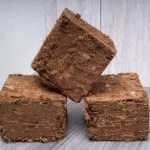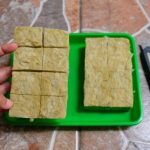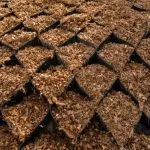Coco coir is becoming increasingly popular as a growing medium in hydroponic systems due to its excellent water and oxygen retention properties. Made from the husks of coconuts, this organic and sustainable medium provides quality root structure and plant yields, making it an ideal choice for hydroponic gardeners. Additionally, its fibrous texture adds a unique aesthetic to your hydroponic system and provides plenty of air pockets, which encourages healthy root growth.
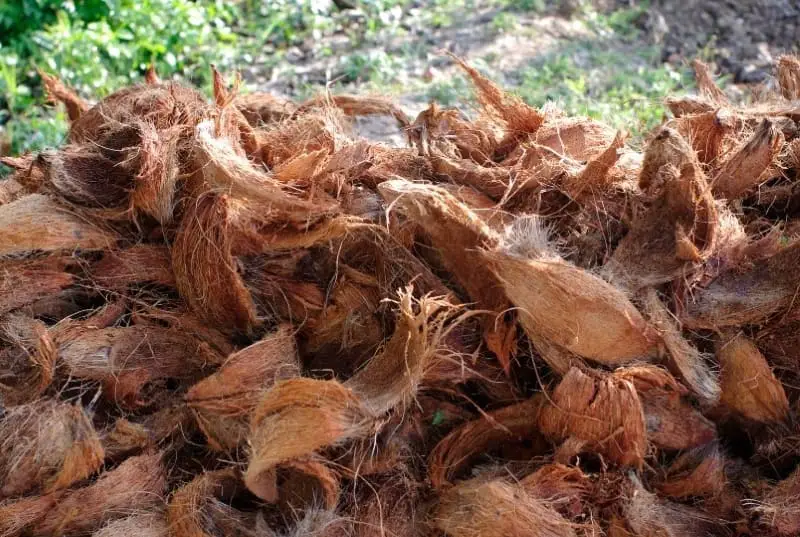
As a hydroponic gardener, you may be wondering how to incorporate coco coir into your system effectively to reap its many benefits. With its ability to provide proper drainage and prevent waterlogging, coco coir is not only well-suited for seed-starting purposes but also as a potting soil alternative. Its water retention properties make it difficult to overwater, allowing your plants to stay healthy and vibrant.
Incorporating coco coir into your hydroponic system may take some fine-tuning, such as testing dissolved solids and ensuring that the coir is properly rinsed and hydrated before use. However, with a little patience and effort, you’ll quickly see the positive impact this versatile growing medium can have on your hydroponic garden’s overall health and productivity. In this guide, we’ll show you how to use coco coir for hydroponics, so you’ll see how easy it really is!
- Understanding Coco Coir
- Coco Coir Vs Coco Fiber
- Benefits of Growing in Coco Coir
- Disadvantages and Potential Challenges with Coco Coir
- How to Prepare Coco Coir for Hydroponics
- How to Buffer Coco Coir
- Nutrient Management and Maintaining Plant Health in Coco Coir
- Proper Aeration and Drainage Techniques
- Coco Coir as a Growing Medium for Different Plants
- How Much Coco Coir for a 5 Gallon Pot
- Frequently Asked Questions
Understanding Coco Coir
Origin and Processing
Coco coir is derived from the outer husk of coconuts, which is the part between the seed and the shell. This natural and sustainable resource is processed into a growing medium, offering its users various benefits. The processing involves one of several methods to produce a versatile growing medium suitable for hydroponics or soil preparations.
Common Forms
When it comes to using coco coir in hydroponics, you will encounter four main forms:
- Coco Coir Fiber: This form consists of long strands of coconut fiber, allowing for greater aeration and drainage in your hydroponic system. These fibers are often mixed with other coco coir products to improve their properties and create a more balanced growing medium.
- Coco Peat or Coco Pith: This is the most finely ground form of coco coir. It has excellent water retention properties and can hold up to 10 times its weight in water. It is ideal for seed starting or mixed with other forms of coco coir to create the perfect balance of water retention and drainage for your plants.
- Coco Chips: These are similar in appearance to wood chips and provide great aeration for plant roots. They can absorb water well but also drain excess water efficiently.
- Coco Coir Bricks: These are compressed blocks of coco coir that come in various sizes that are easy to store and transport. To use them, simply soak the brick in water, and it will expand, resulting in a loose and fluffy medium perfect for your hydroponic system. They are more economical in the long run as they expand significantly when water is added.
Related: You can find all of the above forms in gardening stores or online. We have curated our top picks of coco coir that work well in hydroponic systems.
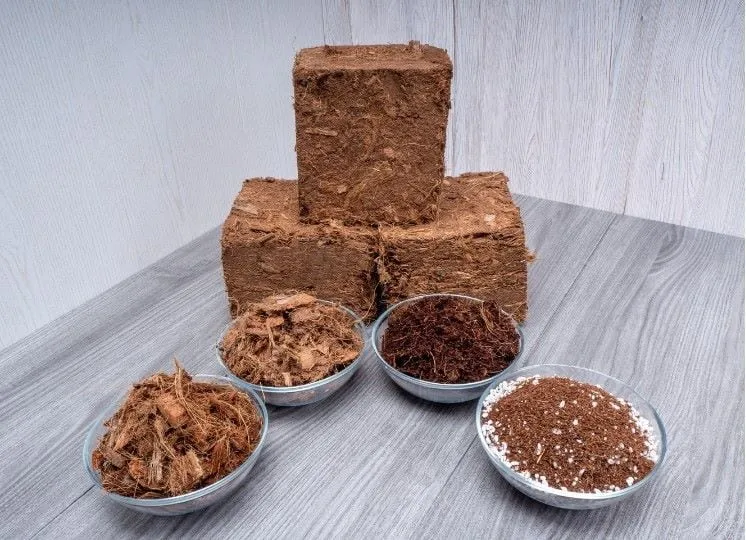
Coco Coir Vs Coco Fiber
Coco coir and coco fiber are both derivative products of the coconut husk and are often confused due to their similar names. However, they have distinct roles and properties when it comes to hydroponics and coco coir is generally the preferred choice over coco fiber.
Coco coir, also known as coconut coir or simply coir, is a product made from the fibrous material found between the outer husk and the actual coconut. It’s a versatile medium, especially in hydroponic gardening, due to its impressive water retention capabilities and excellent aeration. This balance keeps the roots of plants well-hydrated without the risk of waterlogging or suffocation. Moreover, coco coir is pH neutral, which is important for nutrient absorption in hydroponics.
On the other hand, coco fiber or coconut fiber is a rawer form of the material. It’s essentially the same material as coco coir but hasn’t undergone the same degree of processing. As a result, coco fiber tends to have longer strands and retains less water compared to coco coir. This makes it less suitable for hydroponic applications as a stand-alone medium, but it can be beneficial when mixed with other materials to improve aeration in more traditional soil-based growing mediums.
Benefits of Growing in Coco Coir
Coco coir is a popular growing medium choice for hydroponics due to its many benefits. It’s eco-friendly, sustainable, and provides the necessary characteristics for successful plant growth. Here are a few reasons why you should consider using coco coir in your hydroponics system.
- Firstly, coco coir has excellent water retention properties. This means that it can hold onto water longer, ensuring that your plants have continuous access to the water they need to thrive. This is particularly useful in hydroponics, where consistent water availability is key. Additionally, coco coir aids in oxygen retention, providing your plants with the air they need for healthy growth.
- Coco coir also promotes good aeration, which means that the roots of your plants can access air more easily. This is important for the overall health of your plant’s root system, as proper airflow prevents the roots from suffocating. Good aeration also increases drainage capabilities, ensuring that your plants’ roots don’t become waterlogged.
- An added bonus of using coco coir is that it’s an eco-friendly and sustainable option. Unlike peat moss, which is harvested from non-renewable sources and contributes to environmental destruction, coco coir is made from the husks of coconuts, a renewable resource. This makes it a more earth-friendly choice for your hydroponic system.
- Finally, using coco coir can be cost-effective, as it is often inexpensive compared to other growing mediums. This means you can save money on this aspect of your hydroponics system while still providing your plants with an excellent environment for growth.
Disadvantages and Potential Challenges with Coco Coir
When using coco coir for hydroponics, it’s essential to be aware of the following disadvantages and potential challenges:
- Salt Build-up: Coco coir may contain high levels of potassium, sodium, and chloride ions, leading to a salt build-up in your hydroponic system, affecting the pH level and damaging plant roots. Before you plant in coconut husk, flushing or buffering it thoroughly before using it to remove any excess salts and nutrients is recommended.
- Calcium and Iron Absorption Issues: Coco coir is known to bind with calcium and iron, which could make these nutrients less available to your plants. To address this, provide a well-balanced nutrient solution to compensate for coco coir’s binding properties.
- pH Level Fluctuations: The natural pH of coco coir typically ranges between 5.5 and 6.8. To maintain a stable pH level in your hydroponic system, you may need to monitor and adjust the pH regularly to prevent it from becoming too acidic or alkaline for your plants.
- Disintegration Over Time: Coco coir can break down over time, losing its structure and affecting its water-holding capacity. To ensure successful long-term growth, monitor the coco coir’s integrity and replace it as needed.
By understanding and addressing the disadvantages and challenges of using coco coir in hydroponics, you can improve your system’s performance and enjoy a successful growing experience for your plants. If you’re looking for an alternative to this growing medium, consider using Rockwool vs coconut coir.
How to Prepare Coco Coir for Hydroponics
Coco coir is created from the coconut’s outer husk or pith and is available in various forms, including chips, peat, and blocks. To prepare coco coir for your hydroponic system, follow these simple steps:
- Choose the right form of coco coir: Depending on your hydroponic system and plant needs, you can select between coco pith, chips, or a mix of both. Coco peat has excellent water retention properties and is perfect for seedlings, while coco chips provide better aeration and drainage, making them ideal for more mature plants. If you want to buy it in the form of blocks, you will have to break them down into chips and hydrate them well before use.
- Rehydrate the coco coir: Place your brick of coco coir in a container and completely cover it with warm water. Let it sit for at least 15 minutes, allowing it to absorb the water. Once it’s hydrated, fluff the coco coir with a fork or your hands until it reaches a soil-like consistency. Bricks are deceptively small and expand quite a bit once they’re hydrated!
- Rinse and buffer the coco coir: To remove any excess salts and prevent nutrient lockout, rinse the hydrated coco coir with plenty of water. Then, buffer the coco coir by soaking it in a solution of calcium nitrate and magnesium for 12 to 24 hours to help balance the pH.
- Test and adjust the pH: The ideal pH level for coco coir in hydroponic systems is between 5.5 and 6.5. To ensure your plants thrive, test the pH after buffering and adjust it accordingly with pH up or down solutions.
- Prepare your hydroponic system: Now that your coco coir is ready, add it to your hydroponic system and incorporate it with other growing mediums if necessary. Since coco coir is so versatile, you can easily adapt it to various hydroponic systems such as nutrient film technique (NFT), aeroponics, or drip systems.
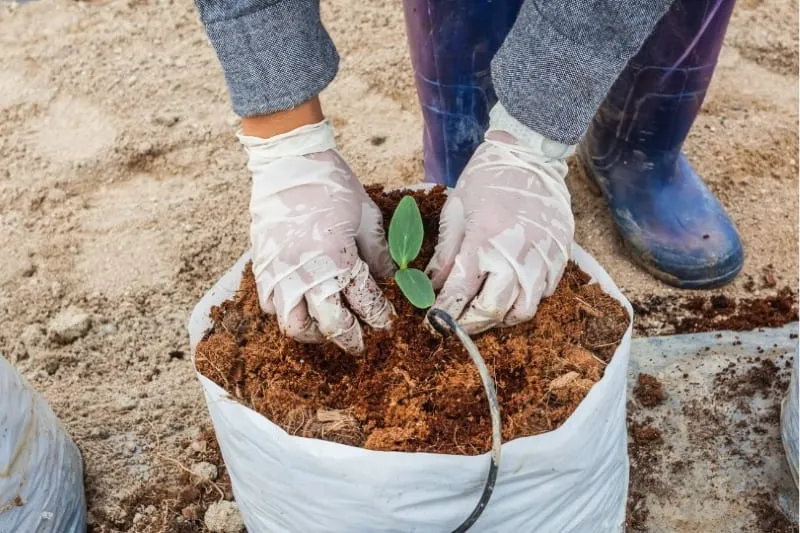
How to Buffer Coco Coir
As mentioned above, one step in the preparation of coco coir before planting is buffering it. Buffering coco coir is necessary to adjust the cation exchange capacity (CEC) and to avoid potential nutrient issues down the line.
Here are the steps:
- Rinse the Coco Coir: Start by rinsing your coco coir with clean water to remove any dirt, dust, or particles. This step will also help to remove naturally occurring salts in the product.
- Prepare a Buffering Solution: You need to mix a buffering solution with calcium nitrate and magnesium (Epsom salt). Use a ratio of about 8 grams of calcium nitrate and 4 grams of Epsom salt per gallon of water. Stir the solution until the salts are completely dissolved.
- Soak the Coco Coir: Soak the coco coir in the buffering solution for at least 8-12 hours. This allows the coco coir to absorb the calcium and magnesium, which displaces the potassium and sodium that can interfere with nutrient absorption in your plants.
- Drain Excess Solution: After soaking, let the excess solution drain out. The coco coir should be damp but not soaking wet.
- Rinse Again: Rinse the buffered coco coir once more with plain water. This helps remove any remaining excess salts.
Nutrient Management and Maintaining Plant Health in Coco Coir
Does coco coir have nutrients? While coco coir is a fantastic growing medium for hydroponic systems, it’s important to know that it is inert and doesn’t naturally contain all the nutrients your plants will need to thrive. A few trace elements are present, but there are some essential elements that need to be supplemented. You’ll have to effectively manage nutrients and fertilizers for healthy plant growth.
Is coco coir good for plants? Absolutely! Coco coir is an excellent growing medium for your hydroponic garden. First, always choose a high-quality coco coir product that has been pre-treated beforehand to remove any excess salt content. This will prevent any salt build-ups that could harm your plants.
Next, ensure that your coco coir is properly irrigated. Coco coir has excellent water retention properties, but it’s essential to supply your plants with enough water for their needs. Maintaining a proper moisture level in the coco coir helps to deliver oxygen to your plants’ roots, promoting healthy growth. Learn about how to water plants in coco coir.
Next, you’ll need to implement a fertilization plan. Since coco coir lacks some vital nutrients such as nitrogen, phosphorus, zinc, and magnesium, you’ll need to add a well-balanced fertilizer to your water supply. A complete hydroponic nutrient solution or a coco-specific nutrient supplement are great options for providing the required nutrients for your plants.
When fertilizing, pay particular attention to the nitrogen levels. This essential nutrient is responsible for the vegetative growth of your plants. Coco coir has a natural ability to absorb some of the nitrogen that’s present. Adjusting the nitrogen-to-potassium (NPK) ratio in the nutrient solution to meet the specific requirements of your plants can ensure that they are getting the optimal amount.
Coco coir also helps maintain a healthy environment for your plants by supporting beneficial microorganisms and fungi. These organisms play a vital role in breaking down organic nutrients and making them available to your plants. To encourage the growth of these beneficial organisms, it’s a good idea to use organic nutrients in conjunction with your coco coir. Organic nutrients not only supply your plants with essential elements but also promote the growth of beneficial microorganisms and fungi.
Lastly, always use pH balanced water for irrigating your coco coir hydroponic garden. Many plants thrive in a slightly acidic environment, and coco coir naturally tends towards a neutral to slightly acidic pH. Using pH balanced water helps ensure that your plants can efficiently uptake nutrients and maintain their overall health.
By incorporating these considerations in managing nutrients in coco coir, you’ll ensure that your hydroponic plants grow strong and healthy. Remember to choose a quality coco coir product, provide a balanced nutrient solution, adjust the NPK ratio based on your plants’ needs, and maintain the proper pH levels throughout the growing process. With all your efforts, you’ll be well on your way to reaping the benefits of hydroponically grown plants.
Proper Aeration and Drainage Techniques
When using coconut coir for hydroponics, it’s essential to pay attention to proper aeration and drainage techniques. A well-aerated and drained growing medium ensures that your plants’ roots get enough oxygen, leading to healthy growth and resilience against diseases.
To achieve good aeration and drainage, consider mixing coco coir with other materials such as vermiculite. Vermiculite is a natural mineral that can enhance aeration by creating air pockets within the growing medium. It also helps in retaining moisture, ensuring that your plants have enough water.
To create the right mixture, start with a ratio of 70% coco coir and 30% vermiculite. Adjust this ratio depending on your plants’ needs and how they respond to the medium. Remember, your goal is to achieve a balance between water retention and air content.
When preparing your hydroponic system, ensure there are enough drainage holes at the bottom of your container. This will allow excess water to escape, preventing root rot and maintaining optimum aeration levels.
Also, avoid overpacking the coco coir mixture into your containers. Allow for some space and looseness, which creates room for air pockets that contribute to aeration. Regularly check the aeration levels in your hydroponic system by monitoring the moisture and oxygen content.
Coco Coir as a Growing Medium for Different Plants
Coco coir is an excellent growing medium with a wide range of applications, making it ideal to use across a variety of plants and stages in their growth cycle. It’s an eco-friendly alternative to traditional potting soil. Let’s take a look at some specific plants and how coco coir benefits them.
For seedlings, coco coir creates a perfect environment to thrive. It is highly absorbent, maintaining the right amount of moisture for delicate young plants without causing waterlogging or root rot. Its airy nature allows for proper aeration, ensuring a well-developed root system.
Coir pots are a fantastic choice if you’re planning on transplanting your plants, especially for garden vegetables and flowers. They are biodegradable, preventing any root disturbance during the transplanting process. Plus, the plant’s root system can penetrate and grow through the coir pot to the surrounding soil.
Now let’s talk about succulents, which generally prefer a fast-draining growing medium with low water retention properties. While coco coir does retain moisture, you can still use it for succulents by mixing it with perlite in a 1:1 ratio. This ensures the proper drainage your succulents need and protects them from overwatering or rotting.
For fruit plants, coco coir can be a game-changer. It allows for improved nutrient absorption and excellent aeration, ensuring that the plants receive all the necessary elements for healthy growth and fruit production. You can expect an increase in the size, quality, and quantity of your harvest.
In summary, while using coco coir for your hydroponics setup, you’ll provide a fantastic environment for various plants to grow and thrive. Whether it’s delicate seedlings or fruit-producing plants, this amazing medium can meet their needs and help them flourish.
How Much Coco Coir for a 5 Gallon Pot
If you’re wondering about how much coco coir to use for a 5-gallon pot, it would depend on whether you’re using it on its own or mixing it with other materials. A 5-gallon pot can hold about 0.66 cubic feet of material.
If you’re using coco coir alone:
- A small brick of coco coir (approximately 650g) will generally expand to between 7-10 quarts of material when hydrated.
- You would need around 2-3 bricks to fill a 5-gallon pot.
If you’re mixing coco coir with other elements like perlite or vermiculite:
- You might use 1-2 bricks of coco coir, depending on how much of the other material you’re adding.
Remember to always check the specific instructions on the packaging of your coco coir, as the exact volume can vary between brands and products.
The amount can also vary depending on the size and life stage of the plants being grown. For young plants or seedlings, start with 2-3 gallons of coco coir to allow room for the roots to establish.
As the plant grows larger and fills out the pot, you may need to add more coco coir up to 4 gallons total for a mature plant. For very large or long term plants, the entire 5 gallon pot can be filled with coco coir to provide maximum support.
The key is to ensure the coco coir provides adequate support and anchoring for the plant’s root system. Starting with less coco coir allows room for roots to expand before filling out the pot.

